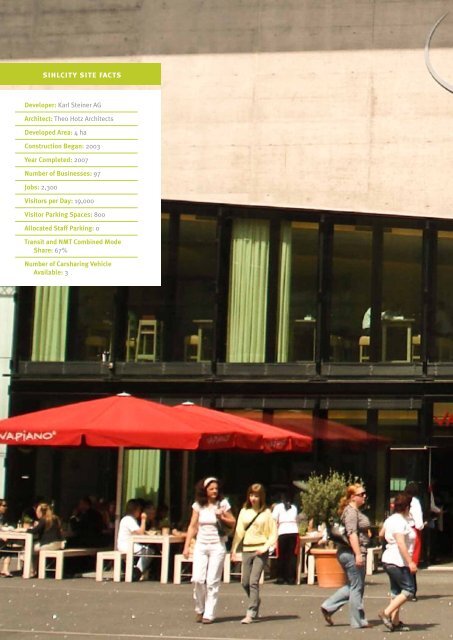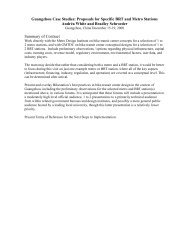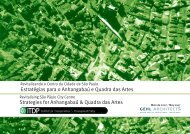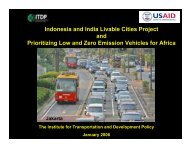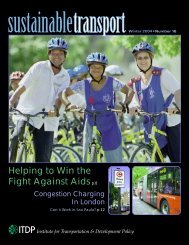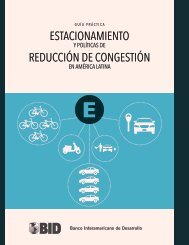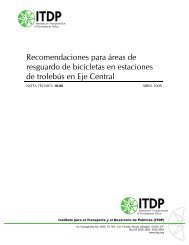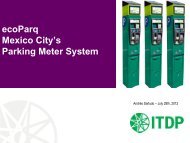sihlcity site facts - ITDP | Institute for Transportation and ...
sihlcity site facts - ITDP | Institute for Transportation and ...
sihlcity site facts - ITDP | Institute for Transportation and ...
Create successful ePaper yourself
Turn your PDF publications into a flip-book with our unique Google optimized e-Paper software.
<strong>sihlcity</strong> <strong>site</strong> <strong>facts</strong><br />
Developer: Karl Steiner AG<br />
Architect: Theo Hotz Architects<br />
Developed Area: 4 ha<br />
Construction Began: 2003<br />
Year Completed: 2007<br />
Number of Businesses: 97<br />
Jobs: 2,300<br />
Visitors per Day: 19,000<br />
Visitor Parking Spaces: 800<br />
Allocated Staff Parking: 0<br />
Transit <strong>and</strong> NMT Combined Mode<br />
Share: 67%<br />
Number of Carsharing Vehicle<br />
Available: 3
case study<br />
Sihlcity<br />
zurich, switzerl<strong>and</strong><br />
Simon Field, <strong>ITDP</strong> Europe
62 Europe’s Vibrant New Low Car(bon) Communities<br />
background<br />
Sihlcity is a new non-residential retail <strong>and</strong> leisure development<br />
located about 2.5 km to the south of Zurich city center (Figure 1). It<br />
is considered best practice because parking is heavily restricted, a<br />
result of a policy in Zurich to only allow new development in <strong>site</strong>s that<br />
have adequate access to public transit as well as walking <strong>and</strong> cycling<br />
facilities, thereby detering new car trips to destinations that might<br />
traditionally attract them. The city uses a “trip access contingent<br />
model” to determine what policies will help keep car trips below a<br />
certain level. In this case the process suggested a reduction in parking<br />
supply, <strong>and</strong> provided incentives <strong>for</strong> the imposition of high usage<br />
costs. Today only 33% of trips to Sihlcity are made by car.<br />
There are 75 shops, 14 cafés <strong>and</strong> restaurants, a cinema, church,<br />
library, hotel, gym <strong>and</strong> medical centre, as well as high quality public<br />
space at Sihlcity (Photo 1). The heart of the development is a fourstory<br />
mall accommodating almost all of the retail businesses. The<br />
<strong>site</strong> was previously occupied by a paper mill, ceased operations in<br />
1990. In 2003 the l<strong>and</strong> was bought by the developer Karl Steiner AG,<br />
which integrated four of the historic buildings into their plans <strong>for</strong> a<br />
new non-residential quarter, named after the River Sihl bordering<br />
the <strong>site</strong> to the east. In 2008 Sihlcity received a European Shopping<br />
Centre Commendation, in recognition of the work of Theo Hotz<br />
Architects in blending the old <strong>and</strong> new, as well as the provision of a<br />
variety of businesses <strong>and</strong> services on the same compact <strong>site</strong><br />
(Sihlcity, 2008).<br />
Large shopping centers are significant trip attractors, <strong>and</strong> without<br />
incentives not to, most people get to them by car. To prevent new<br />
traffic congestion <strong>and</strong> pollution on the routes to Silhcity, the City <strong>and</strong><br />
Canton of Zurich invoked planning regulations to restrict car access<br />
a) as a condition of initial planning permission, <strong>and</strong> (b) in the longerterm<br />
after opening.<br />
This strategy includes parking management, better public transportation,<br />
improvements to infrastructure <strong>for</strong> cyclists <strong>and</strong> pedestrians,<br />
<strong>and</strong> the provision of a sustainable home delivery service.<br />
planning process<br />
According to the Canton of Zurich Structural Plan, “heavily frequented<br />
<strong>site</strong>s” 1 may only be located in areas that satisfy the following<br />
accessibility criteria:<br />
··<br />
A maximum distance of 300 m to a rail station served by at least<br />
one train per hour, or 150 m to a transit stop served by eight or<br />
more trams, buses or trolleybuses per hour;<br />
··<br />
Sufficient road capacity in the surrounding area <strong>for</strong> general traffic;<br />
··<br />
Proximity to existing pedestrian routes <strong>and</strong> cycle networks<br />
Having passed this initial screening, the City of Zurich approved<br />
the plans <strong>for</strong> construction of Sihlcity subject to conditions being<br />
imposed on the <strong>site</strong> owner <strong>and</strong> developer that include:<br />
1 Defined by the Canton of Zurich as <strong>site</strong>s that generate more than 3,000<br />
trips per day on more than 100 days of the year.<br />
Figure 1: Transit routes to <strong>and</strong> from Sihlcity
Sihlcity 63<br />
··<br />
Provision of “recreation quality” space within the <strong>site</strong> (Photo 1);<br />
··<br />
Provision of capital <strong>and</strong> revenue support <strong>for</strong> the following<br />
public transportation improvements: extension of plat<strong>for</strong>ms<br />
at Saalsporthalle S-Bahn (urban rail) station, with a new<br />
pedestrian subway giving access to the <strong>site</strong>; construction of<br />
a subterranean bus station; operation of bus route 89 <strong>and</strong> an<br />
extension to tram route 5 <strong>for</strong> two years (Photo 2);<br />
··<br />
The development must pay <strong>for</strong> the construction of new access<br />
roads <strong>and</strong> links to the existing bicycle network on three sides<br />
of the <strong>site</strong>;<br />
··<br />
Provision of a bicycle-based home delivery service;<br />
··<br />
Parking on the <strong>site</strong> is capped at a maximum of 850 spaces, all<br />
of which must be charged <strong>for</strong>, plus a cap on car trips to the <strong>site</strong><br />
(access contingent).<br />
The access contingent model is a mechanism to impose limits<br />
on the number of trips made to/from a <strong>site</strong> by private car in a given<br />
period, with stiff financial penalties <strong>for</strong> non-compliance. This<br />
provides an incentive <strong>for</strong> the owner of a new development to make<br />
access by alternative means as attractive as possible. The first step is<br />
the calculation of the number of parking spaces permitted, based on<br />
the following criteria in the City of Zurich’s parking regulations:<br />
··<br />
Floor area per building category e.g. offices, retail, restaurants;<br />
··<br />
A reduction factor based on proximity to the city centre;<br />
··<br />
A reduction factor based on transit accessibility level;<br />
··<br />
A reduction factor where local NOx limits are exceeded;<br />
In Zurich’s central old town district, <strong>for</strong> example, a blanket<br />
reduction factor of 90% applies, i.e. the maximum number of spaces<br />
is 10% of the value based on floor space alone. For Sihlcity one<br />
parking place was allowed per 110 m 2 ground floor space, giving<br />
a total of 800 spaces.<br />
The “specific trip generation” per space per day, evening period<br />
<strong>and</strong> peak hour is capped under a <strong>for</strong>mula based on the categories<br />
of expected visitors. This <strong>and</strong> estimated price elasticities then<br />
in<strong>for</strong>m the level of parking charges (Table 1). The maximum car trip<br />
contingent values <strong>for</strong> Sihlcity are as follows:<br />
··<br />
10,000 trips per day, decreasing to 8,800 by 2012;<br />
··<br />
1,300 trips at night;<br />
··<br />
800 trips per peak hour.<br />
key policy <strong>and</strong> design measures<br />
A two-fold travel dem<strong>and</strong> management strategy is in place at Sihlcity:<br />
high parking costs to “push” visitors <strong>and</strong> workers out of private<br />
cars, rein<strong>for</strong>ced by parking restrictions in the surrounding area, <strong>and</strong><br />
high quality local <strong>and</strong> city-wide transit <strong>and</strong> non-motorized transport<br />
infrastructure to “pull” people onto alternatives.<br />
Parking<br />
Parking management discourages trips to Sihlcity by car: spaces are<br />
few <strong>and</strong> expensive. There are 850 spaces in the on-<strong>site</strong> multi-story<br />
car park, of which 50 are allocated to park & ride season ticket<br />
holders, but none to Sihlcity workers.<br />
Parking charges are listed on the Sihlcity web<strong>site</strong> <strong>and</strong> are<br />
in Table 1. A stay of up to four hours costs 7 Swiss Francs (chf),<br />
comparable with the 1–2 zones transit day ticket at 8 chf. However,<br />
residents of Zurich can avail themselves of a range of period passes<br />
<strong>for</strong> one or more zones in the Zurich Verkehrsverbund (integrated<br />
transportation authority area), a national travel pass (GA card) or<br />
national half-fare card, reducing the real <strong>and</strong> perceived costs of transit<br />
significantly 2 . As there are no discounts <strong>for</strong> those employed on the<br />
<strong>site</strong>, it is prohibitively expensive to commute by car. Table 1 shows<br />
that it costs 20 chf to park at Sihlcity <strong>for</strong> an eight-hour working day.<br />
2 Over 400,000 GA cards <strong>and</strong> 2.27 million half-fare cards were sold in<br />
2009; 35% of the Swiss population own one of these mobility passes.<br />
Sources: SBB (2009) <strong>and</strong> FSO (2010).<br />
Table 1: Sihlcity parking charges<br />
Time (hours)<br />
Daytime rate<br />
08:00 – 20:00 (chf) *<br />
Evening rate<br />
20:00 – 08:00 (chf) *<br />
< 1 2.50 2.50<br />
1 – 2 3.50 3.50<br />
2 – 3 5.00 5.00<br />
3 – 4 7.00 7.00<br />
4 – 5 10.00 8.00<br />
5 – 6 12.00 9.00<br />
6 – 7 15.00 10.50<br />
7 – 8 20.00 12.00<br />
8 – 9 25.00 13.50<br />
9 – 10 30.00 15.00<br />
10 – 11 35.00 16.50<br />
11 – 12 39.00 18.00<br />
12 – 24 39.00 39.00<br />
* 1 chf = 0.75 eur = 0.95 usd<br />
Sihlcity
64 Europe’s Vibrant New Low Car(bon) Communities<br />
1<br />
Public space<br />
in the heart of<br />
Sihlcity<br />
The Sihlcity<br />
entertainment center<br />
has an ample amount<br />
of public space, as<br />
opposed to surface<br />
parking lots that are<br />
commonly seen in<br />
similar centers in the<br />
U.S. <strong>and</strong> Europe.<br />
2<br />
The <strong>site</strong> developer<br />
paid <strong>for</strong> the<br />
extension of<br />
plat<strong>for</strong>ms at<br />
Saalsporthalle<br />
S-Bahn station,<br />
adjacent to the<br />
Sihlcity mall.<br />
3<br />
Sihlcity underground<br />
bus station, with lift<br />
<strong>and</strong> steps to the main<br />
square.
Sihlcity 65<br />
4<br />
Prominently<br />
displayed public<br />
transport departure<br />
in<strong>for</strong>mation in the<br />
heart of Sihlcity.<br />
5<br />
The main entrance<br />
to Sihlcity from<br />
Sihlcity Nord is<br />
reserved <strong>for</strong> cyclist<br />
<strong>and</strong> pedestrians,<br />
motorized traffic is<br />
prohibited.<br />
6<br />
Bicycle parking<br />
next to storage<br />
lockers<br />
Customers can<br />
store cold groceries<br />
while running other<br />
err<strong>and</strong>s or take<br />
advantage of lowcost<br />
delivery service<br />
via electric bike.
66 Europe’s Vibrant New Low Car(bon) Communities<br />
Figure 2: Recommended pedestrian (green) <strong>and</strong> cycle (orange) routes into Sihlcity<br />
A fine of 50 chf is payable by vehicle owners attempting to leave<br />
without paying the correct fee.<br />
The surrounding area is a controlled parking zone with no onstreet<br />
parking <strong>for</strong> non-residents, critical to avoid shoppers or workers<br />
from just parking on residential streets <strong>and</strong> inconveniencing the<br />
adjacent community. However, the multi-story car park is directly<br />
connected to the mall <strong>and</strong> the local road network via two new access<br />
roads. The A3 motorway from Zurich to Chur can be accessed at a<br />
junction 0.5 km to the south of Sihlcity at Brunau. Thus the limited<br />
supply <strong>and</strong> cost of parking is the only policy “stick,” with much<br />
greater reliance on the “pull” measures described below.<br />
Public <strong>Transportation</strong><br />
The area is very well served by transit, with traffic-free access routes<br />
to the most heavily used stops. No part of the development is more<br />
than 250 m from Sihlcity Nord tram <strong>and</strong> bus stop, 150 m from the<br />
extended plat<strong>for</strong>ms at Saalsporthalle station (Photo 2) <strong>and</strong> 150 m<br />
from the <strong>site</strong>’s own underground bus station (Photo 3). The use of<br />
step-free, low-floor vehicles is detailed in Table 2.<br />
Transit routes <strong>and</strong> frequencies are summarized in Figure 1 <strong>and</strong><br />
Table 2. As in most European cities, a Zurich ZVV single trip ticket<br />
allows unlimited changes to reach one’s destination, minimizing the<br />
inconvenience of interchange. Trams, buses <strong>and</strong> trains are timed to<br />
connect at many hubs, as is the case across much of Switzerl<strong>and</strong>.<br />
Printed timetables, maps <strong>and</strong> fare in<strong>for</strong>mation are displayed at all<br />
stops <strong>and</strong> in the central public square, with electronic departure<br />
boards located on the square <strong>and</strong> inside the mall (Photo 4).<br />
A comprehensive network of tram <strong>and</strong> suburban rail (S-Bahn) services<br />
<strong>for</strong>m the backbone of Zurich’s transit system, complemented<br />
by buses <strong>and</strong> trolleybuses serving lesser-used <strong>and</strong> orbital routes.<br />
Routes, timetables <strong>and</strong> fares are set by the ZVV Verkehrsverbund<br />
(transit agency), which is also responsible <strong>for</strong> in<strong>for</strong>mation provision<br />
<strong>and</strong> marketing, allowing full intra- <strong>and</strong> inter-modal integration across<br />
the city region: the slogan “one ticket <strong>for</strong> everything” is part of the<br />
ZVV logo. The municipal operator of the city’s tram <strong>and</strong> bus network,<br />
VBZ, has heavily marketed the improved transit service to Sihlcity,<br />
focusing on the com<strong>for</strong>t <strong>and</strong> frequency of tram routes 5 <strong>and</strong> 13 with<br />
the slogan “changing makes sense.”<br />
There are location maps, route maps <strong>and</strong> timetables at all stations<br />
<strong>and</strong> you can purchase the most popular tickets with coins at<br />
most stations. An increasing number of city centre stops have touchscreen<br />
machines offering a greater variety of passes <strong>and</strong> destinations:<br />
these accept coins, credit <strong>and</strong> debit cards, <strong>and</strong> will eventually<br />
replace the coin-only terminals.<br />
Heavily-used stops feature electronic departure boards, some<br />
of which can display real-time in<strong>for</strong>mation. All stops are shown<br />
in the online mapping service Google Maps, together with the times<br />
of the next two departures per route <strong>and</strong> links to full timetables<br />
on the ZVV web<strong>site</strong>. Real-time next stop <strong>and</strong> connectional in<strong>for</strong>mation<br />
is announced, <strong>and</strong> in most cases displayed electronically, in<br />
trams, trains <strong>and</strong> buses.<br />
Zurich has a zonal fare structure, with a range of personal (nontransferable)<br />
<strong>and</strong> transferable monthly <strong>and</strong> annual passes available<br />
<strong>for</strong> either (a) travel without restriction, or (b) travel at any time outside<br />
the hours of 05:00–09:00 on weekdays: the latter cost half the<br />
price of the unrestricted versions, starting from 693 chf, or 519 eur,<br />
<strong>for</strong> the annual personal pass covering the entire metropolitan area.<br />
75% of Zurich residents possess at least one transit season pass
Sihlcity 67<br />
Table 2: Transit routes to <strong>and</strong> from Sihlcity<br />
Route<br />
Sihlcity stops<br />
served<br />
Details<br />
Mon – Fri<br />
peak<br />
frequency<br />
Mon – Sat offpeak<br />
frequency<br />
Sunday<br />
frequency<br />
Step-free<br />
vehicles?<br />
Train S4 Saalsporthalle City radial<br />
routet<br />
Mon – Fri peak<br />
frequency<br />
20 mins 20 mins No<br />
Trams 5<br />
<strong>and</strong> 13<br />
Sihlcity Nord<br />
City radial<br />
route<br />
3–4 mins 3–4 mins 10 mins Some<br />
Trolleybus<br />
33<br />
Sihlcity Nord<br />
City inner<br />
orbital route<br />
6.5 mins 7.5 mins 10 mins Some<br />
Bus 89<br />
Sihlcity<br />
(bus station)<br />
City outer<br />
orbital route<br />
7.5 mins 15 mins No service Yes<br />
Postbuses Sihlcity /<br />
Saalsporthalle<br />
To/from rural<br />
hinterl<strong>and</strong><br />
30 mins Mostly hourly (no<br />
Saturday service)<br />
No service<br />
Yes<br />
Author’s<br />
elaboration<br />
(Stadt Zürich, 2007). Books of six one-day <strong>and</strong> single-trip tickets<br />
are also available. A Junior Travelcard costing 20 chf per year allows<br />
accompanied children up to the age of 16 to travel free. Carsharing<br />
membership can be bundled with these options.<br />
Bicycles can be carried on buses, trolleybuses <strong>and</strong> trams subject<br />
to space, <strong>and</strong> on S-Bahn trains at off-peak times.<br />
The electricity generation mix across Switzerl<strong>and</strong> as a whole is<br />
55% renewable (largely hydro-electric) <strong>and</strong> 41.1% nuclear 3 , while<br />
that of the national railway system is 73.5% hydro-electric <strong>and</strong> 26.5%<br />
nuclear. This clearly demonstrates the value of modal shift from the<br />
car to electrified transit in particular, as a core element of the Swiss<br />
climate change mitigation strategy.<br />
Pedestrian <strong>and</strong> Cycling Infrastructure<br />
Within the <strong>site</strong>, the main access route from Sihlcity Nord <strong>and</strong> the<br />
central public square are free of motorized traffic <strong>and</strong> shared by<br />
cyclists <strong>and</strong> pedestrians (Photo 5). Access from the west is via a new<br />
subway under Saalsporthalle station: this <strong>and</strong> the southern access<br />
point are linked to existing cycle paths via newly constructed paths.<br />
Access routes <strong>for</strong> pedestrians <strong>and</strong> cyclists (Figure 2) are described<br />
in a printed leaflet, <strong>and</strong> were available to download from the Sihlcity<br />
web<strong>site</strong> until September 2010.<br />
Bicycle lanes in the surrounding area are either on the road,<br />
separated from other traffic by yellow painted lines, or on the pavement<br />
(sidewalks), especially at the busy Sihlcity Nord junction. A<br />
dedicated traffic-free route runs along the river <strong>for</strong> approximately<br />
one kilometer towards the city centre: detailed printable <strong>and</strong> audio<br />
guides <strong>for</strong> leisure walks from the city centre are downloadable from<br />
the Sihlcity web<strong>site</strong>.<br />
Bicycle use is further encouraged through the provision of 600<br />
covered parking spaces in four locations across the <strong>site</strong> (Photo 6).<br />
Storage Facilities <strong>and</strong> Home Deliveries<br />
Many people drive to shopping centers because it is usually the<br />
easiest way to transport purchases back home. Sihlcity offers a<br />
number of innovative services to encourage the use of sustainable<br />
modes by shoppers.<br />
Storage lockers of varying sizes are available on-<strong>site</strong>, with<br />
modest fees of no more than 4 chf <strong>for</strong> up to six hours. An innovation<br />
demonstrating Sihlcity attention to detail is the provision of lockers<br />
chilled to 12°C, ideal <strong>for</strong> the storage of fresh <strong>and</strong> dairy produce.<br />
A bicycle-based delivery service <strong>for</strong> groceries <strong>and</strong> other small<br />
items of up to 40 kg is provided through the community association<br />
Züriwerk, which provides opportunities <strong>for</strong> disabled people in Zurich.<br />
Goods, including chilled perishables, can be left with Züriwerk at any<br />
time between 09:00 <strong>and</strong> 20:00, avoiding the need to rent a locker,<br />
with the actual delivery taking place at a time of the customer’s<br />
choosing. The st<strong>and</strong>ard price is 8 chf to any destination within the<br />
city. Deliveries averaged fifty per day in 2009, up from twenty in<br />
within the first hundred days of opening.<br />
Carsharing<br />
Three carsharing vehicles, including one station wagon 4 , are available<br />
to rent from the park & ride area of the car park through Mobility<br />
Carsharing Switzerl<strong>and</strong>. The annual membership fee is 290 chf, or<br />
150–190 chf <strong>for</strong> holders of national or regional annual transit passes.<br />
Members pay between 2.70 <strong>and</strong> 4.20 chf per hour, <strong>and</strong> a distance fee<br />
of between 0.25 <strong>and</strong> 0.92 chf per km, depending on vehicle type <strong>and</strong><br />
total distance travelled. Vehicles can be located <strong>and</strong> reserved online<br />
<strong>and</strong> by telephone. More in<strong>for</strong>mation, including eco-driving tips, is<br />
available on the Mobility Carsharing web<strong>site</strong>.<br />
This organization offers cars at 190 <strong>site</strong>s in the City of Zurich, <strong>and</strong><br />
at a total of 379 <strong>site</strong>s in Zurich Canton, putting a large proportion of<br />
the population within easy reach of one. Over 10,000 people hold a<br />
combined ZVV annual public transportation <strong>and</strong> Mobility membership<br />
pass, <strong>for</strong> an additional fee of 150 chf, plus the hire charges<br />
outlined above. Interestingly, a separate tariff <strong>for</strong> infrequent users<br />
is also offered: bundled membership is available <strong>for</strong> only 25 chf,<br />
with users paying an extra 1 chf per hour when using a vehicle. This<br />
discourages frequent use if a reasonable alternative is available.<br />
Un<strong>for</strong>tunately the cars are not available <strong>for</strong> one-way hire, requiring<br />
users to return them to Sihlcity: this implies additional trip generation<br />
rather than substitution. Unsurprisingly, use of these vehicles<br />
is low, with 1,040 recorded trips per day from Sihlcity in 2009, equivalent<br />
to about three trips per day, or one per vehicle (Schmid, 2010;<br />
pers. comm.). Alternatively, members can pick up vehicles in their<br />
own neighborhood, then drive to Sihlcity <strong>and</strong> back, although they<br />
face the same parking charges as other car users. The marginal effect<br />
3 0.005 kg CO2 / kWh. Source: Ecopassenger (2010).<br />
4 Estate or combi car.
68 Europe’s Vibrant New Low Car(bon) Communities<br />
Figure 3: Mode of travel to Sihlcity<br />
100%<br />
modal share by number of trips<br />
80%<br />
60%<br />
40%<br />
20%<br />
private<br />
motorized modes<br />
other modes<br />
0%<br />
2008<br />
2009<br />
De Tommasi, 2008;<br />
De Tommasi, 2009<br />
Table 3: Quantitative comparison of the Sihlcity <strong>and</strong> Letzipark leisure <strong>and</strong> retail developments.<br />
Site<br />
Number of<br />
shops<br />
Number of<br />
restaurants<br />
<strong>and</strong> cafés<br />
Number of<br />
parking<br />
spaces<br />
Cost of<br />
parking <strong>for</strong><br />
three hours<br />
Distance to<br />
tram stop<br />
Distance to<br />
rail station<br />
Sihlcity 75 14 850 5 chf 250 m via<br />
traffic-free<br />
route<br />
Letzipark 57 9 1,500 Free 250 m via busy<br />
streets<br />
On-<strong>site</strong><br />
800 m<br />
Author’s<br />
elaboration<br />
of Sihlcity carsharing vehicles on travel dem<strong>and</strong> might be negligible,<br />
or even slightly adverse, but the overall impact of membership on<br />
car ownership <strong>and</strong> vehicle kilometers travelled should be considered<br />
when assessing the efficacy of carsharing. Mobility Carsharing<br />
Switzerl<strong>and</strong> has 90,000 members, with an estimated 18,000 fewer<br />
car movements per day as a result (Mobility Carsharing Switzerl<strong>and</strong><br />
web<strong>site</strong>, accessed 15 July 2010).<br />
quantitative analysis<br />
Prior to the opening of Sihlcity, 1,350 people (boarders <strong>and</strong> alighters)<br />
used Sihlcity Nord tram stop per day. This more than doubled to<br />
an average of 3,100 per day within the <strong>site</strong>’s first 100 days of business.<br />
User surveys estimated that non-car modes accounted <strong>for</strong> 70%<br />
<strong>and</strong> 67% of visitor trips in 2008 <strong>and</strong> 2009 respectively, com<strong>for</strong>tably<br />
beating the target of 60% (Figure 3) (Sihlcity, 2010). This compares<br />
with the national figure of 8–9% of shopping trip stages being made<br />
by transit in 2005 (FSO, 2009).<br />
These data are not split further into transit vs, cycling or walking,<br />
but it is likely that transit dominates: City of Zurich statistics reveal<br />
that 64% of all trips involving two or more modes (including walking)<br />
include a transit component (Stadt Zürich Tiefbauamt, 2008).<br />
The car park has spare spaces on weekdays, but fills to capacity<br />
on Saturdays. Car users stay <strong>for</strong> 2.5 hours on average, paying 5 chf<br />
to do so. Of the daily limit of 8,800 car trips allowed under the trip<br />
contingent model, approximately 3,600 were made in 2008. Average<br />
car occupancy is 1.6 persons, consistent with the national figure <strong>for</strong><br />
Switzerl<strong>and</strong>. 30% of visitors used a car in 2009, compared with 38%<br />
<strong>for</strong> all shopping <strong>and</strong> leisure trips in Switzerl<strong>and</strong>. Although there are<br />
no data available, it is highly likely that car use among Sihlcity workers<br />
is negligible owing to the lack of free allocated car parking.<br />
An interesting comparison may be made with the Letzipark<br />
shopping centre, located 2.5 km to the north-west of Zurich city<br />
centre (Table 3).<br />
Unlike Sihlcity, Letzipark is geared towards serving motorists: a<br />
petrol station <strong>and</strong> car dealership are located on-<strong>site</strong>. Public transportation<br />
comprises a radial trolleybus route, an orbital bus route <strong>and</strong> a<br />
local bus feeding the tram system. Access to high quality rail-based<br />
public transportation is considerably less convenient than in Sihlcity.<br />
More importantly, the Letzipark web<strong>site</strong> (accessed 26 October 2010)<br />
boasts of 1,500 parking spaces, despite its smaller size, which are<br />
free to use <strong>for</strong> up to three hours. “Women only” bays are located<br />
close to the exits, increasing the attractiveness of multi-story car<br />
parking at night. The “how to get here” pages of each web<strong>site</strong> are<br />
noticeably different: Letzipark’s displays in<strong>for</strong>mation <strong>for</strong> car users,<br />
with a separate link to a transit route planner, whereas Sihlcity’s<br />
offers more detailed public transportation in<strong>for</strong>mation alongside<br />
transit <strong>and</strong> car route planners. The walking <strong>and</strong> cycling map shown<br />
in Figure 2 was available on the Sihlcity web<strong>site</strong> (accessed 14 July<br />
2010), but has subsequently been removed.
Sihlcity 69<br />
lessons learned<br />
Encouraging the use of sustainable modes <strong>for</strong> shopping trips is a<br />
major challenge, especially when bulky or heavy loads are purchased.<br />
Nevertheless, the City of Zurich <strong>and</strong> Sihlcity have addressed<br />
this issue by (a) using the price <strong>and</strong> limited supply of parking as the<br />
key policy tool to deter private car use, <strong>and</strong> (b) providing improved<br />
transit, storage <strong>and</strong> delivery alternatives that people find convenient<br />
to use. This was facilitated through the planning system, including<br />
the City’s stringent planning regulations <strong>for</strong> heavily frequented <strong>site</strong>s:<br />
planning permission was conditional on satisfying accessibility planning,<br />
maximum parking st<strong>and</strong>ards <strong>and</strong> car trip contingent criteria.<br />
This is a model that other cities could adopt as part of their spatial<br />
planning strategies <strong>and</strong> guidance.<br />
The Sihlcity strategy relies on a large proportion of visitors<br />
already owning one of the many types of integrated transit pass<br />
available (from 1.90 chf per person per day), since the cost of<br />
undiscounted one-day tickets within the city <strong>for</strong> a family of four<br />
(27.20 chf), plus bicycle-delivery (8 chf), compares poorly with the<br />
3–4 hour parking fee of 7 chf, or 7-hour stay <strong>for</strong> 15 chf. Although<br />
there are fuel <strong>and</strong> vehicle maintenance costs to consider, these are<br />
generally perceived by car users to be negligible in terms of marginal<br />
trip costs. The carsharing vehicles on <strong>site</strong> are a useful back up <strong>for</strong><br />
car-free visitors who may have made more or heavier purchases<br />
than anticipated, but do not contribute to a reduction in motorized<br />
vehicle kilometers. A better solution <strong>for</strong> retail centers might be just<br />
increased availability of taxis <strong>and</strong> the creation of a taxi st<strong>and</strong> at a<br />
central location <strong>for</strong> customers who are too laden down with packages<br />
to take other modes.<br />
The use of non-motorized modes to access Sihlcity is believed<br />
to be relatively low. Possible ways to address this are the use of<br />
personal travel planning <strong>and</strong> awareness-raising campaigns on <strong>site</strong>.<br />
Free bicycle trailer hire could also help: this is offered by the British<br />
supermarket chain Waitrose <strong>and</strong> would be simple to integrate into<br />
the Züriwerk delivery facility.<br />
Exp<strong>and</strong>ing the use of low-floor vehicles on transit routes to/<br />
from Sihlcity may help maintain or even exp<strong>and</strong> the already high<br />
number of people who use transit to reach the <strong>site</strong>. Happily, the<br />
transit agency has a strategy to convert S-Bahn route S4 by 2014 <strong>and</strong><br />
eliminate remaining high-floor trolleybuses by the end of 2013 (ZVV,<br />
2008): this will improve accessibility <strong>for</strong> those laden with shopping<br />
bags <strong>and</strong> using pushchairs, as well as the elderly <strong>and</strong> disabled. In<br />
contrast, the key priority <strong>for</strong> the tram system is expansion, including<br />
the “Glattalbahn” tram network in the north of the city, rather than<br />
the replacement of older vehicles or the addition of low-floor centre<br />
sections to a further batch of “Tram 2000” vehicles. However, the<br />
Swiss Disability Discrimination Act requires that transit buildings<br />
<strong>and</strong> vehicles be fully accessible to the disabled by the end of 2023<br />
(Federal Office of Transport, 2006).<br />
In terms of the transferability of the Sihlcity experience, a prerequi<strong>site</strong><br />
is a comprehensive, frequent, reliable, af<strong>for</strong>dable, clean<br />
<strong>and</strong> com<strong>for</strong>table transit system. Simply increasing the cost of parking<br />
alone is unlikely to be successful, given the availability of alternative<br />
retail <strong>and</strong> leisure facilities with free or low-cost parking.<br />
sources<br />
Cairns S., Sloman, L., Newson, C., Anable, J.,<br />
Kirkbride, A. <strong>and</strong> Goodwin, P. (2004). Chapter<br />
Eight in Smarter Choices: Changing the Way We<br />
Travel. Department <strong>for</strong> Transport, London.<br />
De Tommasi, R. (2008). Heavily Frequented Sites:<br />
New Playgrounds <strong>for</strong> Mobility Management.<br />
Presentation at the 2008 ECOMM Conference,<br />
London.<br />
De Tommasi, R. (2009). A good example of<br />
integration: Sihlcity, Zürich, Switzerl<strong>and</strong>. Online<br />
presentation <strong>for</strong> the EPOMM project “MAX:<br />
Successful Travel Awareness Campaigns &<br />
Mobility Management Strategies.”<br />
Ecopassenger (2010). http://ecopassenger.<br />
hafas.de/hafas-res/download/Ecopassenger_<br />
Methodology_Report.pdf (accessed 21 July 2010).<br />
Federal Office of Transport (2006). http://www.<br />
bav.admin.ch/mobile/01244/01258/index.<br />
html?lang=en (accessed 27 October 2010).<br />
FSO (2009). Mobility <strong>and</strong> Transport: Pocket<br />
Statistics 2009. Swiss Federal Statistical Office,<br />
Neuchâtel.<br />
FSO (2010). http://www.bfs.admin.ch/bfs/portal/<br />
en/index/themen/01/01/key.html (accessed 27<br />
October 2010).<br />
Letzipark: http://www.letzipark.ch<br />
Mobility Carsharing Switzerl<strong>and</strong>: http://www.<br />
mobility.ch<br />
SBB (2009). http://mct.sbb.ch/mct/en/konzern_<br />
kennzahlen (accessed 15 July 2010).<br />
Schmid, S. (2010). E-mail correspondence from<br />
Stefan Schmid of Mobility Carsharing, received<br />
27 July 2010.<br />
Sihlcity (developer web<strong>site</strong>): http://www.<strong>sihlcity</strong>.ch<br />
Sihlcity (2008a). http://www.<strong>sihlcity</strong>.ch/<br />
downloads/medienberichte_de/PR_<br />
Shopping%20Center_Award_17_04_08.pdf<br />
(accessed 8 June 2010).<br />
Sihlcity (2010). http://www.<strong>sihlcity</strong>.<br />
ch/downloads/medienberichte_de/<br />
Medienmitteilung-Geschaeftsjahr_2009.pdf<br />
(accessed 14 July 2010).<br />
Stadt Zürich (2007). Mobilität und Verkehr 5/2007.<br />
Stadt Zürich Statistik, Zürich.<br />
Stadt Zürich (2008). Wegtypen und<br />
Aktivitätsmuster im Verkehrsraum Zürich.<br />
Datengrundlage Mikrozensus Verkehrsverhalten<br />
2005. Stadt Zürich Tiefbauamt, Zürich.<br />
ZVV (2008). Strategie 2011–2014. Zürcher<br />
Verkehrsverbund, Zurich. http://www.zvv.<br />
ch/export/<strong>site</strong>s/default/common-images/<br />
content-image-gallery/unternehmen-pdfs/ZVV_<br />
Strategiebericht_farbig2011-2014.pdf (accessed<br />
27 October 2010).<br />
Image credits<br />
Figures 1, 2: Sihlcity.<br />
Photo 1: Andre Lardon via Flickr<br />
Photos 2–4, 6: Simon Field, <strong>ITDP</strong> Europe<br />
Photo 5: Sihlcity<br />
We would like to thank Roberto de Tommasi<br />
<strong>for</strong> providing additional in<strong>for</strong>mation.


